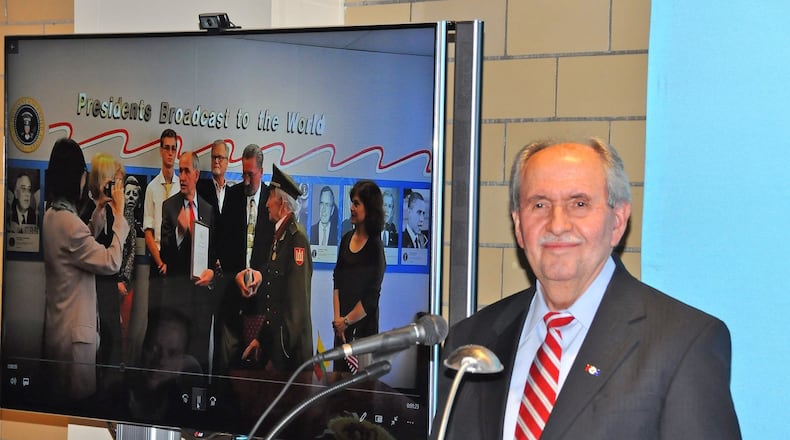“Compared to a few years ago, the world is less democratic, and media is less free and independent,” said Elez Biberaj, Voice of America Eurasia division chief, to 100 people at the VOA museum. “We are witnessing a widespread assault on the truth and attempts to manipulate public opinion and disseminate blatantly false news and information. Social media are becoming political battlefields, manipulating the truth and spreading disinformation.”
Biberaj, a 40-year career employee of the VOA in Washington, D.C., who has been VOA Eurasia division chief since 2005, has the depth of knowledge and experience of a Cold War expert. He visited the museum as the culmination of its year-long event series marking the 75th anniversary of the VOA Bethany Station.
His presentation focused on challenges VOA faces as it continues its 77-year history of providing accurate, reliable and comprehensive news to oppressed countries outside the U.S. that lack a free press.
VOA’s Eurasia division reaches 14.7 million per week and encompasses the Soviet Union and southeast Europe. Its coverage includes Russian, Ukrainian, Albanian, Armenian, Bosnian, Georgian, Macedonian, and Serbian language programs. VOA news reaches 275 million people weekly worldwide, making it the U.S.’s largest international broadcaster.
The Eurasian division has become a prime target of Russian disinformation programs, said Biberaj. Disinformation is defined by Dictionary.com as false information intended to “mislead, especially propaganda issued by a government organization to a rival power or the media.”
Thirty years after the Fall of the Berlin Wall, freedom in Eurasia remains fragile, said Biberaj. Few former communist countries have transitioned to full democratic state status.
Freedom House, an independent watchdog organization dedicated to the expansion of freedom and democracy around the world, ranks Eurasia as one of the most repressive areas in the world, said Biberaj.
“Russia is rated as ‘not free,’ he said, “and the other former communist countries are rated ‘partly free.’”
He told the audience that Russia today uses a “range of tools and tactics to target communities, countries and environments” through disinformation narratives designed to sow chaos and distrust, as well as “discredit democracy and present Putin’s Russia as a viable governing alternative” to democracy.
Examples he gave included:
—RT, formerly known as Russia Today, and Sputnik websites now operate in more than 100 countries, including the U.S., flooding media markets with false or misleading information;
—Russia uses social media bots and fake accounts to influence elections in other countries and to promote Moscow narratives;
—Russia has changed the borders of Ukraine and Georgia and supported ethnic, religious and race conflicts in Kosovo-Serbia and Macedonia;
—Russia has undermined the NATO membership efforts of Montenegro and North Macedonia.
Other threats to press freedom emerging in former Soviet bloc countries that hold democratic elections and have free press laws on the books include a “subtle form of self-censorship,” said Biberaj.
“Many media outlets are controlled by big business and they cannot cover certain stories or risk losing income,” he said. “The result is a widespread lack of trust in media and a lack of business accountability.”
In Hungary and Serbia, for example, he said, citing Freedom House, media ownership has been consolidated into the hands of government allies. Eighty percent of media in Hungary is owned by Russian government allies.
There are similar problems in other parts of the world where VOA journalists—as well as other journalists worldwide— are routinely harassed, detained, arrested, beaten or even killed. Other countries VOA covers where this occurs include Pakistan, Myanmar, Venezuela and Turkey.
Despite the rise in disinformation worldwide and the weaponization of social media to spread it, VOA believes that the best way counter bad information is good information and narratives based on truth, said Biberaj.
“Our experience is that when crises erupt, our audience numbers go up, because people want to turn to a trusted source,” he said.
VOA audiences surveyed worldwide from 2012 to 2017 gave it an average 85 percent trust rate, he said, citing VOA statistics. 2018 figures have not yet been released. These figures compare to a September Gallup poll measuring audience trust in U.S. mass media at 41 percent.
For more information about VOA, visit www.voanews.com. For more information about VOA museum exhibits and events, visit www.voamuseum.org.
About the Author
